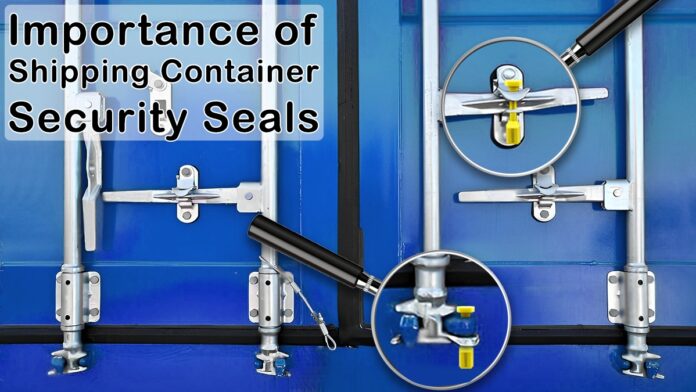Table of Contents
A shipping container seal, known as a cargo seal, is a mechanism that is used to protect and indicate the integrity of shipping containers while they are being transported. A container seal’s principal function is to prevent unwanted access to the container and to protect the contents from theft, manipulation, or contamination.
The importance of the Shipping Container Seals

When you are planning merchandise to specific destination, one of your first priorities should be to secure your merchandise. All shipping containers are delivered by ocean freight, whether FCL or LCL. Just like you would lock your house door to protect your personal things, you need to apply the same method to your shipping container as well.
The Need for Shipping Container Seals is created now, they are an essential component of international shipping, used to secure the container doors after the goods have been loaded. After that there are several places that the container has been passed such as origin port, vessel on board, transshipment ports, destination port, and finally consignee’s warehouse.
The duration of a container’s journey from the shipper’s warehouse to consignee’s warehouse, delays might occur because of incorrect documentation, port and labor union strikes, transport vessel breakdowns, and other reasons. Some occasions delays can be more than a month. But if your Shipping Container Seal ensures that the container has been properly “sealed” at the point of origin, and the seal may only be opened once, the container cannot be opened during the journey until it arrives at its destination.
Shipping Container Seal not only prevents goods theft, but also reduces the chance of an unauthorized individual getting entry to the container and transporting unlawful cargo, such as contraband or drugs. Moreover, seals are designed to withstand harsh weather conditions and safeguard the container on its journey.
Containers are used to transport several types of cargo that have different temperature requirements, such as dry, chilled, or frozen goods. Cargo can be further categorized as perishable, non-perishable, pharmaceuticals, and further categories and all FCL and LCL containers must be sealed during shipment, as required by shipping Lines, ports, government authorities, and importers/exporters.
In some cases, shippers are loading high value products, highly perishable food items, or pharmaceuticals and shippers need empty containers are sealed before being sent for stuffing to prevent tampering and maintain container cleanliness or a set-temperature.
Shipping lines – They have their own policies regarding the approval of the various types of seals that they allow.
For example, Evergreen, MSC, Maersk Line, CMA-CGM and COSCO all have their own policies with slight variations.
Different Types of Shipping Container Security Seals
There are various types of container seals. They are available in a variety of shapes, sizes, and price ranges. Each seal contains a unique alphanumeric identification number, which is used to make sure that it wasn’t damaged/changed during the container’s the journey.
- STEEL BOLT SECURITY SEALS
- PLASTIC CARGO SECURITY SEALS
- STEEL CABLE SECURITY SEALS
- METAL STRIP SECURITY SEALS
- E-SEALS
- PADLOCK SEALS
- THE METER SEALS
- C-TPAT COMPLIANT SEALS
- INDICATIVE SEALS
- SECURITY SEALS
- HIGH SECURITY SEALS
More details about each seal type
Placing a container seal correctly: How and Where to place it
Seals can be placed on a shipping container in six different “security seal placements”, but the most effective place where the container seal needs to be put is on the right door, as will be opened first. In general, there is no rule on how many seals you must put on a shipping container, Every shipping container must have at least one seal before it to be shipped. All container seals are issued and supplied by the shipping line with which the booking was made. and they have their own Seal Management Policies, you must follow the policy before shipped your container.
Seal Management Policies of Carriers
- Maersk Line Container Seal Policy
- CMA-CGM Container Seal Policy
- Evergreen Container Seal Policy
- Cosco Line Container Seal Policy
- MSC Line Container Seal Policy
- Hamburg Sud Container Seal policy
- Hapag Lloyd Container Seal Policy
- ONE Line Container Seal Policy
- OOCL Container Seal Policy
- HMM Container Seal Policy
- PIL Container Seal Policy
- YML Container Seal Policy
- Wanhai Container Seal Policy
- Zim Container Seal Policy
3 Steps of placing a container seal correctly

Read More about – How to Place a Shipping Container Seal Correctly
The Different Regulations in Terms of Container Sealing
In general shipping company have their own policies of shipping container sealing, your shipment may through several customs, and different customs regulations are apply in different countries , therefore the type of a container security seal to use may vary depending on the destination and on the carrier. Reputed shipping lines required that their container must be sealed and that should complies with requirements of the international ship and port facility security (ISPS Code), international customs system and ISO 17712 standard.
The Requirements of the ISO 17712 Standard
ISO 17712 standard is the recommended standard for shipping container seals that is accepted globally.
ISO 17712 establishes uniform procedures for,
- Classification
- Acceptance
- Withdrawal of acceptance of mechanical shipping container seals
The purpose of mechanical seal is part of a security system to determine whether a container has been tampered with.
ISO 17712 standard defines 3 types of classes of seal strength
- I – indicative
- S – Security
- H – High Security
C-TPAT requires the use of “H” class seals
According to the ISO 17712 seals on international containers should be as follows,
- Unique
- Tamper Proof
- Easy to Examine
- Single Use
- Unchangeable Characteristics of the Seals
- Must desinged and manufactured according to the anti-fraud characteristics
- The supplier is required to offer a certificate of compliance confirming that security seals meet the standard specifications
Port & Customs Requirements for Container Seals
Port and customs authorities often require a container to have at least one seal in order to pass through customs, moreover under the guise of legitimate cargo, smugglers frequently transport drugs, to deter this port and customs officials are carry out random inspections.
In this case customs officials conduct selective supervision of unstuffing of import containers or transshipment containers to ensure compliance with regulatory requirements, also they check all goods conveyed in the containers have been accurately declared to customs.
In this process they will have to break the container seal affixed by the shipper and after supervision customs officials, they fixed a new customs seal for container.
Removing the Shipping Container Seal
Before remove the container seal its good practice to check the present seal condition. If your seal is cut, seal barrel is out of shape, sign of damage, wear and tear, unusual marks that signifying that a heavy tool has been used to remove it, you must notify the below parties asap.
- Cargo Handler
- Insurance Company
You must open container / broke the seal only presence of representatives of these parties
In other way seal number should match with bill of lading (B/L) and other shipping documents , also numbers should match seal pin and it’s seal barrel, any mismatch you must notify the below party asap.
- Shipping line
- Cargo handler Representative
- Consignee Representative
- The insurance representative
These parties need to conduct for joint survey if there evidence of tampering the seal and should only be opened once they are present, if customs open seal, you can see the custom seal on your container.
The container seals are removed using heavy duty metal seal cutters or bolt cutters. however its not much easier that you thinking, depending on the strength of seal it might take few efforts to cut, it should be cut along it’s length which is the pin of the seal.
Caution – Wear eye protection where appropriate, while removing security seal.
Why are container seals important?
Container seals play an important role in protecting cargo integrity and security during transportation. They assist in the prevention of theft and tampering, as well as ensuring that goods reach at their destination undamaged.
What types of container seals are commonly used?
Bolt Seals
Cable Seals
Plastic Seals
Metal Seals
How do container seals work?
Container seals are typically locked by passing a bolt or cable through the locking body. Once closed, the seal cannot be removed without leaving evidence of tampering, as it will break or reveal signs of forced entrance.
Who uses container seals?
Container seals are used to safeguard items during transportation by shipping firms, logistics providers, manufacturers, exporters, and importers. Seals are also used by government organizations and customs officials to ensure cargo security and to expedite inspections.
Can container seals be reused?
Most container seals are intended for one-time usage only. They cannot be resealed after they have been removed, requiring a fresh seal for each shipment.
How do I choose the right container seal for my needs?
The suitable container seal is determined by criteria such as the level of security necessary, the type of goods being delivered, and any applicable legislation. Consulting with a professional security seal provider will assist you in selecting the right seal for your specific requirements.
Disclaimer: The views expressed by the authors in this article do not necessarily reflect the views of CONTAINER SURVEYOR. Data and charts, if utilized, in the article have been sourced from available information and have not been authenticated by any statutory authority. The author and CONTAINER SURVEYOR do not claim it to be accurate nor accept any responsibility for the same. The views constitute only the opinions and do not constitute any guidelines or recommendation on any course of action to be followed by the reader.


